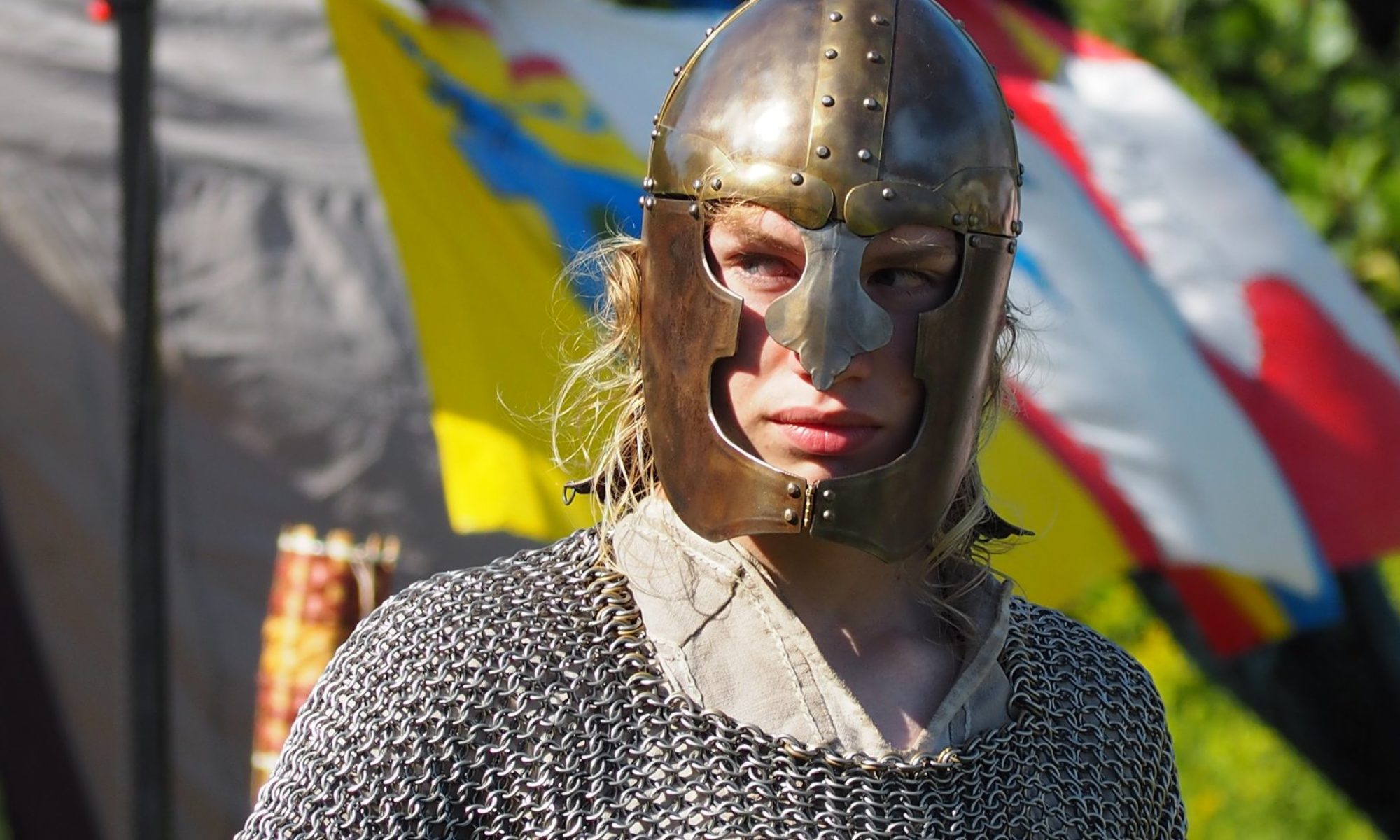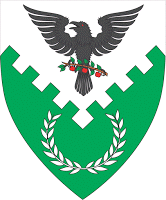For many people, their first event will be one of our local feasts. These are a bit different from other community dinners you’ve probably been to beyond just the way we dress!
You probably already know that you will need to come dressed in something Medieval. If you don’t have anything pre-1600 in your closet, we do have some loaner Medieval clothes (or “garb”); talk to our Chatelaine to make arrangements to borrow some from our Gold Key. Alternatively, for women, a full-length plain (not patterned) skirt (the fuller, the better), something like a peasant’s blouse, and a scarf to hide short hair will do just fine for your first visit. For men, you can wear a pair of brown pants and a plain shirt, and you can make a “tabard” by taking a rectangle of unpatterned cloth, as wide as your shoulders and twice as long as from your shoulders to your mid-thighs, and cutting a hole for your head in the middle. Put it on like a long poncho, hanging down front and back, and put a plain brown or black leather belt over it, and that will work for your first visit.
If you decide to keep coming to feasts, our Arts and Sciences Mistress can help you make some garb of your own. Lots of places sell it online as well and we’ll be happy to help you find the right garb for you.
So, now you’re properly garbed! On to the feast!
–You’re going to have to bring some stuff along.
At some feasts, the food is cooked and served to you; but many SCA feasts (including most of ours) are potluck, so you’ll need to bring some food to share. The rule of thumb is to being enough for ten to twenty people to have a taste of it.
Also, while it doesn’t need to be an actual Medieval recipe, it needs to at least not look out of place, and should be served on an appropriate dish or platter. For example, a bucket of fried chicken wouldn’t fit in; but a supermarket roast chicken on a wooden cutting board would work just fine.
Remember to bring the necessary serving utensils, and write your name on your dishes.
There’s also some other things you’ll need to bring to any SCA feast you attend, as feasts don’t generally supply more than the bare tables and chairs, so you’ll need to bring everything else to eat with and to make your table look nice. Again, talk to Gold Key to see what you can borrow if you are missing something vital:
–Plates. You are going to want at least one plate or a bowl; it’s a good idea to have a plate and a bowl; but it is perfectly period to share them with the person beside you. Nowadays that is most likely to happen if you are a couple or a parent and child. Traditionally the nicest bits go to the lady but I leave you to sort that out for yourselves. Don’t be grabby if you’re sharing, though! Generosity is a virtue.
Incidentally, wooden or (non-leaded) metal are better than ceramic; ceramic looks lovely but breaks very easily. Also you’d have to be quite rich to have it. Because it breaks very easily.
–Goblet/drinking horn/beer stein, for drinking. It’s fine to start out with a stein; they’re cheap and easy to find and look just fine; just avoid modern designs on them (that includes the bas-relief deer). Plain pewter ones are great; choose the ones with metal bottoms rather than glass if you have a choice; again, glass breaks. Don’t leave pop cans on the table!
–Eating knife or dagger; spoon. This is not the same as a steak or a bread knife; think more like a small dagger (which works fine) or a sword-shaped letter opener. It’s more for spearing things than cutting; most food will be eaten with fingers so it will already be cut up. Forks are only around in late period and their use was kind of side-eyed for a very long time (think the look you’d give someone eating pizza with a knife and fork), and so not very common at all. Spoons are helpful for soups, stews, and very crumbly food but you can probably get by with sopping it up with bread if needed. Finding period-looking metal ones is easy online and difficult in most stores, so you will probably want to go with a nice wooden one. Good news: you can find cheap ones that look good, too.
–Candles. The lights in the hall will be turned out; you provide your own light. I’d suggest two at a minimum but take as many as you think you need. Bring period-looking candle-sticks or votive candles in a period-looking container (the hall may not allow candlesticks due to fire regulations but if so will usually says so in the event copy), extra candles, and don’t forget the matches!
–Drink. The feastocrats (those running the feast) will often have at least water available but not always and not always anything else. Bring some juice if you want it and be aware that while some feasts will allow alcohol (“wet” or “discretely wet”), others will be “dry”, and that may be a part of the hall’s rental agreement, and may be rigidly enforced. But you will want to have something to drink, and especially to make toasts with, even if it is just water. Use period containers (jugs, etc) ideally; at the least, put the mundane container into a fabric bag for pouring and hide it under the table.
–Table cloth. A large thin shawl will do just fine (but be wary of stains, don’t use your best Pashmina), as will a couple of metres of cheap cotton fabric or a plain flat sheet. You just want to cover up the bare plastic surface and make it look attractive. A nice cloth, a couple of cheap metal dollar store candelabra and candles, a thrift-store round wooden platter and salad bowl, and a cheap pewter beer stein, and you already have a really decent-looking board!
–Plastic bag to put your dirty dishes in after. Not all feasts have wash stations set up, and even if they do, your dishes will be wet. Do not wash them in the bathrooms! That tends to plug the sinks and earn the ire of the autocrats.
That would be the minimum, but here are some optional items you can bring as well:
–Salt cellar: a small, pretty bowl or box with a tiny spoon, not a shaker. Use the spoon, not your fingers!
–Napkin: We’re eating with our fingers, after all, and you don’t want to drip onto your lovely feast garb! The Tudors would have a white cloth the size of a tea towel folded in half and draped over their left shoulder for wiping their fingers on.
–Cork screw. Even if you don’t need one this time, like matches, it’s helpful to have around.
–Finger bowl: A small bowl of water to rinse your fingers in. Don’t fill it too full.
–Scraps bowl/platter: What it sounds like. A place to put the scraps.
–Basket or chest: to carry all your stuff in. Much easier than juggling it all.
–Banner with tacks or a stand: Depending on the hall set-up, you might be able to either pin your banner to the wall behind you, or set it up on a low free-standing stand. This adds to the atmosphere a lot and makes it easier to find where you’re sitting; but depending on the layout this might not be possible. Little table-top versions are a fantastic idea, though, and fit in anywhere!
–Games. Medieval board games, dice, cards (you can find them online or make your own); these are a great way to pass the time and make new friends.
And if you have children, bring something they can quietly occupy themselves with (medieval-themed colouring sheets, a few not-glaringly-modern toys, games as above, etc), and a few portable snacks (granola bars (hide the wrappers), beef jerky, fruit). It can be a long time for them before the food gets served, and they probably won’t find sitting around talking to adults as absorbing as we do.

